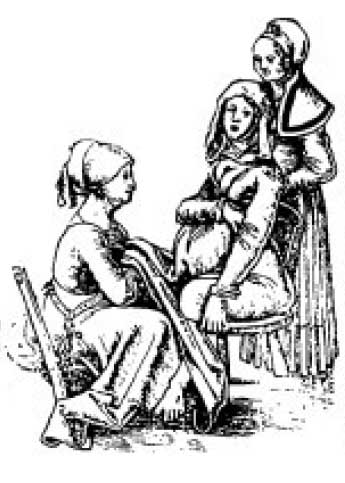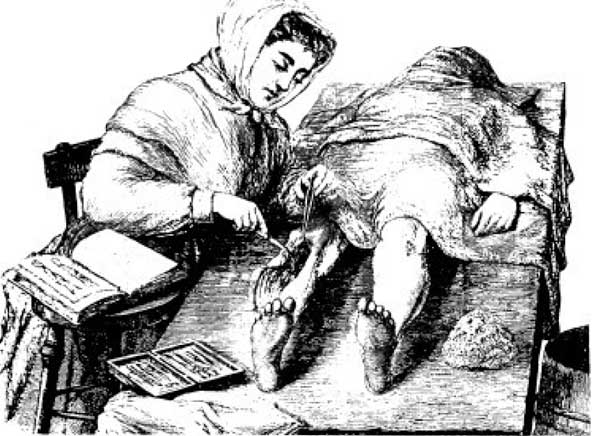by Beatrice Levin
WHEN COMPASSION WAS THE ONLY MEDICINE From earliest times, women have nursed the sick and cared for newborns and the elderly in their homes. Childbirth was entirely in the hands of trained midwives.

From the 13th to 1 5th century, women were responsible for most of the doctoring in hospices, such as the St. Janshopital in Bruges, Belgium.
Barbara Tuchman in A Distant Mirror, the Calamitous 14th Century (Knopf), writes: “Some women practiced as professors or doctors even if unlicensed. In Paris in 1322, a certain Jacoba Felicie was prosecuted by the medical faculty of the University for practicing without their degree of the Chancellor’s license. A witness testified that he had heard it said that she was wiser in the art of surgery and medicine than the greatest master or doctor or surgeon in Paris.”
In the Memling Museum, Bruges, paintings by Jan Beerblock (1739-1806) reveal his imagined view of the sidewards in the 14th century hospice. In the 13th century, this splendid hospice served as a compassionate refuge for the sick and dying and records reveal women were practicing medicine here. Wayfarers found here clean beds and decent meals.
The charitable hospital was the single most valuable contribution of the Medieval West. The Christian religion placed great hope and reliance on the help of God and the saints in the cure of illness.
In Bruges, Sisters tenderly ministered to the sick and dying, and comforted the survivors. Nuns were cooks, laundresses, nurses and scrubwomen. Other women, wives, widows or daughters of physicians, who had passed examinations before a commission, received “licenses to practice” medicine. In the Middle Ages, treatment usually involved “bloodletting” — even before the patient was admitted, often while hospitalized and again when leaving — if the sick soul survived.
Female Arab Doctors: Where Double Standards Meet
The Gulf War, so fiercely opposed by Middle Easterners, caused rejoicing and rebellion among educated, sophisticated Arab women. It wasn’t the war itself that they supported. These women, who still require their husbands’ permission to participate in mixed gatherings and are forbidden to drive cars, thrilled to television images of American women working side-byside with men, flying helicopters, servicing planes, driving trucks, and tending the sick and wounded in military clinics.
As a result, emboldened female doctors in Yemen joined some 70 other protesting women on the streets of Aden to demand the release of political prisoners. In the same city, a woman doctor publically demanded that the government appoint women among the chief magistrates of Aden’s numerous districts. In Syria, 200 women, a number of them physicians, protested in front of the presidential palace in Damascus the continued use of martial law. And in Saudi Arabia, women doctors staged a drive-in to the city in a convoy with 70 other women who had learned to drive abroad.
The sight of women doctors protesting publicly for what is probably the first time in history has placed in sharp relief a glaring contradiction of Middle Eastern society: Throughout Arab history, women, though virtual prisoners outside their homes, are allowed to practice one of society’s most prestigious professions — medicine. This has been true since the beginning of their history.
Thirty-five hundred years before the birth of Christ, the record shows, Egyptian doctors, female and male, were reknowned throughout the world for their close, accurate, empirical observations of human anatomy and illness. Not surprisingly, in the Pharaoh’s court, where physicians had both rank and influence, only women doctors were allowed to minister to the king’s favorite wife, as well as other members of his harem and the royal offspring.
Much later, in 47 BC, after Caesar burned two celebrated royal medical libraries in Alexandria, Arab women trained in medicine performed another crucial service. A few Latin and Greek books escaped the blaze, and, eager to help make them available to a larger audience, these women translated and copied these books. As a result, libraries throughout the Arab world became impressive. In Arab Spain, the Cordova library is believed to have acquired 200,000 volumes of medical texts thanks to the efforts of these dedicated women.
Throughout the middle ages, the study of human anatomy was forbidden in Catholic Europe. Christian dogma detested such “wordly knowledge,” and the Jewish and Moslem religions prohibited the dissection of human cadavers or the pictorial representation of the human body. Only verbal descriptions of parts and sites of organs were permitted. Throughout this period, Arab armies crossed the desert into the west and plundered what few medical texts and anatomical renderings remained. Again it was female Arab copyists who preserved the knowledge of those early Western writings and drawings. They translated them into Arabic, and adapted their drawings and diagrams into written form. It was these women who discovered the error of the previously accepted western belief that the uterus had seven parts.
The historical record also shows that in the eighth century women were among the 6,000 students at Baghdad’s splendid medical school. Despite excellent training, the women were confined to the study and practice of obstetrics and alchemy. But a century later, in Ninth-century Damascus, women doctors were allowed to practice in all areas of medicine. While they were hardly given equal status with men physicians, the most famous doctor of the period, Al Rhazes (860-932), author of the first pediatric book, as well as the first to describe measles, smallpox, and other infectious diseases, paid them grudging respect.
In one of his books he admitted that he had learned what he knew about herbs from women doctors. Headdedthat women physicians were sensibly content first to try small doses of mild medicines on patients, before prescribing the massive doses routinely recommended by their male colleagues. But most notably, this great Islamic clinician observed, “Women have greater humanity than men. Women doctors often succeed with tenderness and optimism.”
No Arab physician and medical author had a greater reputation than Avenzoar, born in Seville around 1091, who became physician to a Sultan. An enemy of quackery, superstition, and astrology, his work was translated into Latin and Hebrew and used in medical schools throughout the world for 500 years. Avenzoar founded one of the great medical dynasties of Mohammedan Spain. His daughter and granddaughter, plus his son, were physicians. Altogether, seven generations of medical women and men descendents carried on his work.
Early Arab women doctors have even been immortalized in literature. One story in The Arabian Nights gives insight into what Arab medical students were taught in the Middle Ages. It tells of an Arabic slave girl who was knowledgeable about medicine, anatomy, and surgery, and knew the answers to questions posed by her medical teachers. She knew which veins to open for bleeding and the antidotes to poisons.
Just as they do today, early Arab women doctors went about with their faces veiled and their bodies covered from head to foot in black robes. (Their male counterparts wore silk robes, damask coats with flowing sleeves, and colorful turbans.)
It wasn’t until the beginning of this century that female Arab physicians began to achieve the authority that their male counterparts have always taken for granted. That was when the Egyptian government appointed a woman physician to head one of its departments. Improbably named Sheldon Amos Elgood, she earned her medical degree at London University, in 1900. She opened the first outpatient department for women and children in an Egyptian government hospital, and later founded the first free children’s dispensaries in Egypt. During her lifetime she won Egypt’s highest honor, the Decoration of the Nile, and was chosen for the Order of the British Empire. In addition, she has won a lasting place in the hearts of Egypt’s female physicians and medical students for whom she is still a role model.
Women doctors have also been leaders in opposing outmoded, superstition-based treatments. As recently as 1961, according to Dorothy Van Ess, author of the study Fatima and Her Sisters, branding was still a favorite cure-all in Arab countries. A patient suffering from jaundice, Van Ess recounts, was advised to drink buttermilk with tumeric, eat watermelons and accept a branding on the left wrist. Stomach trouble was often treated by brandings all over the abdomen. A woman, losing her eyesight as the result of corneal ulcers, had her eyeball branded. Opposition to this long-established, deeply-rooted practice came not from modern, male physicians, but from the women doctors.

Female physicians in the Middle East have also been the ones to buck powerful cultural currents that write off sick people. As one Egyptian doctor observed recently, “The value of human life is considered unimportant. Sometimes the sick are not even brought food. Inshallah, it is God’s will.”
Now, slow change has accelerated into a revolution, albeit a fairly quiet one. Prestigious Arab institutions, like Saudi Arabia’s King Faisal School of Medicine in Damman, founded in 1975 with an international faculty, are now training women doctors in record numbers. In 1978, there were only 318 Saudi nationals practicing medicine in that country. They comprised only eight percent of all doctors in the nation. Yet one-third to one-half of the King Faisal medical students at that time were women. Each year, the number of female medical students increases.
Despite such encouraging progress, men and women students at King Faisal in the 1970s and even now are totally segregated. If the lecturer is male, the women can only hear and see him on closed circuit television. Nonetheless, since the ’70s, young women medical students have been sent by the school into villages for some hands-on experience. At first there was fear that they might be attacked by conservative villagers, or worse, by the paid religious police or the army. But the young women were welcomed. Since then, on these trips, a few daringly have dropped their veils inside villagers’ homes, and others have donned blue jeans under their abayas. The late Roy G. Smith, M.D., their American professor at King Faisal medical school who instituted the trips, later wrote in Behind The Veil in Saudi Arabia (1979), that afterward, both male and female medical students were required to present papers on their field experiences. To begin with, the young men snickered at the reports of the women which they heard through closed circuit TV. But as they grasped the women’s growing aggressiveness, emotional growth, and astute criticism, Smith reported, the snickering stopped.
“We are now at a crossroad,” says Hoda Badran of Egypt, a leading campaigner for women’s rights. Today, at the University of Tunis, an attractive medical student named Rawaa wears jeans, a silk head scarf, and make-up. She could be taken for a Parisian. Rawaa promises to change her society and demand a greater say in her life. “Forget it,” she says at the mention of the traditional arranged marriage.
Like other Arab women, Rawaa is angry. Throughout the centuries, women have always obeyed the rules which men told them were in the Koran. Now young women read the book for themselves and discover that many of these dicta are nowhere to be found. As women doctors increase in numbers and continue to practice in the remote villages and family clinics of their countries, they seem destined to be not just healers of their sick and superstitious compatriots, but of their entire society.
The Hard Fight for Equality
In the United States, women have fought long and hard for equality in the medical profession. But was there less discrimination abroad against women in medicine?
Anecdotal evidence supports the view that most countries have sex-bias built in, in the way women are treated as individuals, as potential scholars and as patients. Surprisingly, women in academia have faced the least disadvantage in Turkey, where they hold at least 25 percent of the Ph.D.s, university positions and M.D.s, and face little bias in the social sciences. However, Turkish women have been emancipated only recently, and then only in cities. There, professional women are free to follow careers, because they can afford to; they pay servants a pittance. In the countryside, Turkish women still live in the 14th century.
Swiss universities were the first to accept women on an equal basis with men. In 1854, the University of Zurich offered undergraduate and medical degrees to women. In the first years, the number of women studying medicine ranged between one and eight, and by 1872-3 climbed to 88. Many of the women studying medicine in Zurich (and later in Bern) were Russian. The undergraduate preparation of the women was unequaled anywhere. The medical faculty reported few problems resulting from mixed classes. Ten women passed the M.D. examination in the early years of the school, and three Russian women achieved the degree in three years instead of the normal four and a half.
When, in 1863-64, a Russian-university charter prohibited the acceptance of women to study science or medicine, Russian women flocked to the University of Zurich. The first Russian women to graduate from the University as physicians were M.A. Bokova and Nadya Prokofievna Suslova. Dr. Suslova graduated within two years of her acceptance to Zurich!
Having prohibited women from pursuing a medical education in Russia, hospitals found a severe doctor shortage on their hands in 1869. As a result, in 1872, the Czarist government opened the Women’s Medical Courses in St. Petersburg. The first degree there was conferred on Varvara Alexandra Kashevarova-Rudneva. She had studied at the Institute for Midwives in St. Petersburg in 1861, and graduated in 1862. After a year of delivering babies, she applied to the MedicoSurgical Academy from which she graduated in December, 1868, with a gold medal for excellent scholarship.
When her name was called, the graduating class gave her an ovation that seemed to rise to the ceiling, sending shock waves through the assembly. Her insignia was presented to her. Her fellow students lifted her on a chair as though she were a bride. She was carried with triumphant songs throughout the hall, while applause thundered around her. By 1879, about a fourth of the total medical school population of Zurich were women; and in 1897, American women studying at Zurich University issued a guide to prospective students, providing helpful information on costs, behavior, course offerings and suggestions on learning German.
Despite the promising beg.,inings, by the 1970s, of all the free world countries, the United States was closest to the bottom in numbers of women physicians, while the Iron Curtain countries had the highest percentage of women health scientists. However, in those nations, medicine held less prestige than in the free world, and even where women had professional positions, men continued to dominate the jobs of supervisors and top management.
Today there are large numbers of women in medicine in the United States, but very few have been able to attain the highest positions in academic medicine.

The Sisters set a precedent for Belgium’s first woman doctor, Anne Catherine Albertine Isala van Diest, (1842-1916), born in Louvain, the daughter of a doctor. Isala, her five sisters and one brother all received the same education, most unusual for the times.
After the death of her brother, Isala was determined to be a doctor. She successfully graduated from the undergraduate college in Berne, Switzerland and, returning home to Louvain, demanded admission to medical school. The rector offered her a chance to take physiology and midwifery only. No, she replied, she wanted a medical degree.
So she went back to Berne where she was admitted to study in the Faculty of Medicine. Van Diest received a medical degree in 1877 with a thesis on a South American medicinal plant. In 1 882-83, she registered for courses in surgery and obstetrics. She practiced in Brussels from 1884 to 1903.
Not until 1890 did the House of Representatives in Belgium “consecrate the right of women to practice medicine and pharmacy,” without discrimination against them, reaffirming a law of 1876 that permitted women to all the “various branches of the art of healing.” The first woman graduate in medicine at Brussels was Clemence Everaert (in 1803), and the first at Ghent is believed to be Bertha DeVriese (in 1900).
Beatrice Levin, a Houston, Texas writer, is the author of Women and Medicine (Media Publishers, 1988). She has written 12 books and more than 400 articles and short stories. She is the recipient of numerous writing awards.
© 1998 2010 On The Issues.
